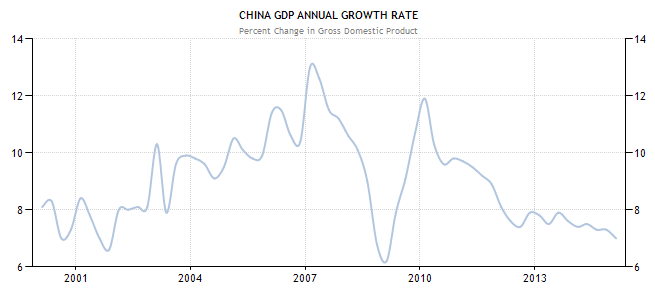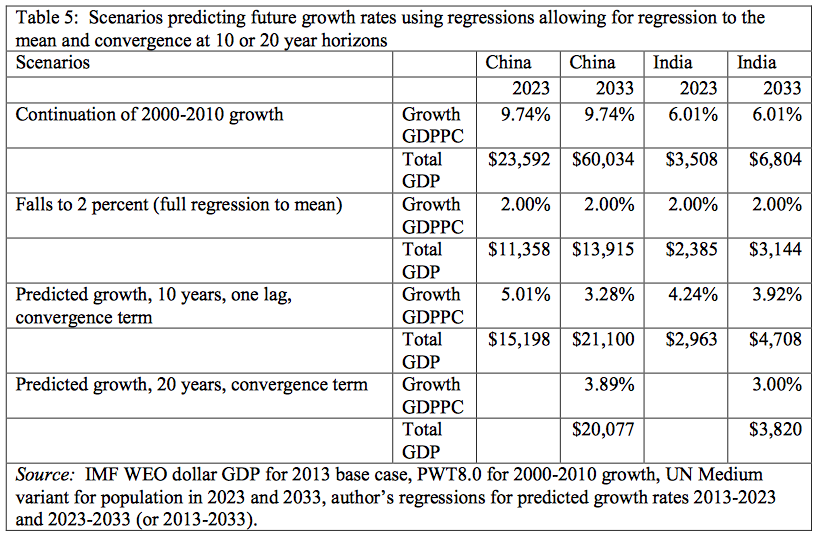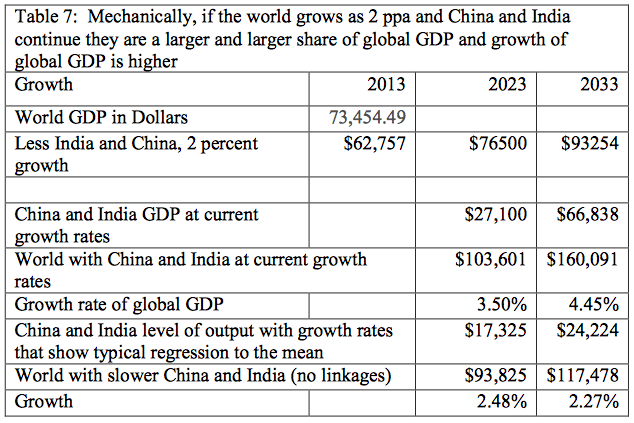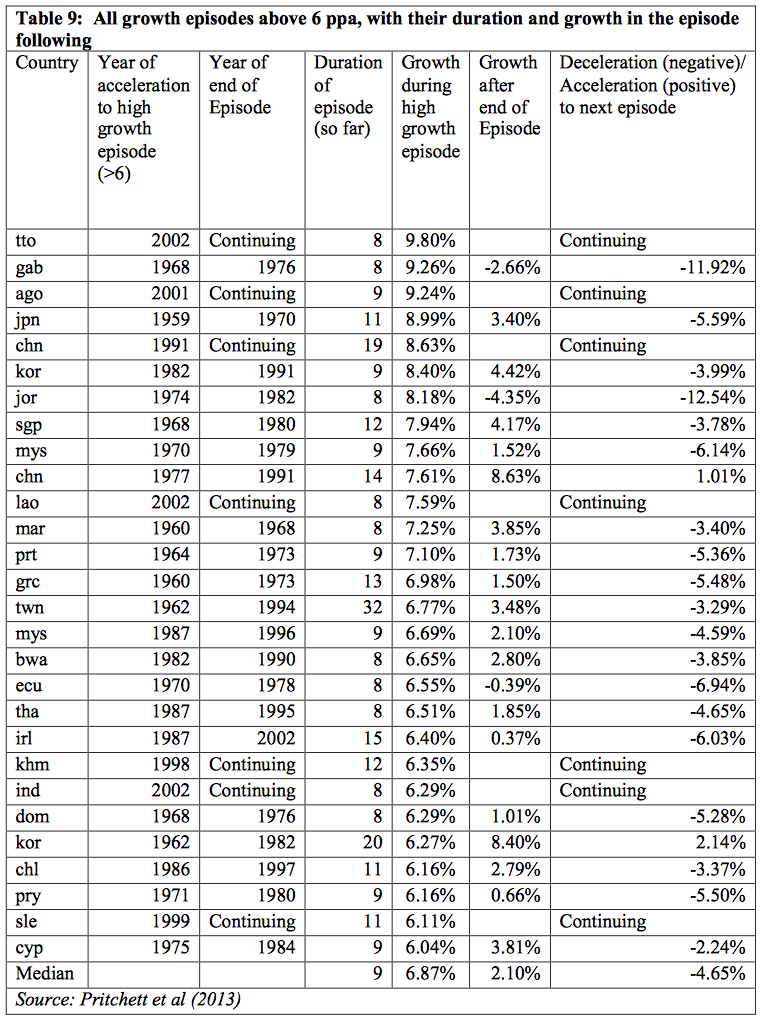Recently, there has been a great deal of discussion about China's slowing economy with projections that growth could "slow" to the 7 percent range. While this is of concern, largely because the global economy has depended on China's phenomenal economic growth rates to prop up the weaker economies of the developed nations, a paper, "Asiaphoria Meet Regression to the Mean", by Lawrence Summers and Lant Pritchett shows that even these projections may be excessively optimistic over the long-term.
Here is a line graph showing China's GDP growth rate since 2000:
Over the decade and a half, China's growth rate peaked at 13 percent in Q1 2007 and hit a low of 6.2 percent in Q1 2009 during the depths of the Great Recession. Keeping in mind that the rest of the developed world was experiencing an economic contraction during this period, China's growth during the global crisis was positively stellar.
According to the World Bank's Global Economic Prospects for 2015, China's growth is forecast to be 7.1 percent in 2015, 7.0 percent in 2016 and 6.9 percent in 2017, compared to an average of 2.2, 2.4 and 2.2 percent respectively for the world's developed economies as shown on this table:
You will note that, even though China's growth rate is projected to slow, by 2017 it is still the second highest among all developing economies after Bangladesh and India.
Now, let's go back to the paper by Summers and Pritchett. The authors open their paper by noting that there are two common failures in economic forecasting:
1.) excessive extrapolation of the (recent) past into the (distant) future with particular susceptibility to irrational exuberance.
2.) excessive subjective certainty that relies on confidence in continuity that consistently under-predicts discontinuities.
The authors note that this is particularly the case in growth projections for China and India; despite the recent somewhat less bullish forecasts, the forecasts of future global economic growth still hinge on growth that is super-rapid in both China and India.
The rise of Asia's economic miracle has taken place in three stages:
1.) the rise of post-World War II Japan.
2.) the rise of the East Asian Dragons, including Korea, Taiwan, Hong Kong and Singapore.
3.) the rise of China and India.
This has produced what the authors term "Asiaphoria".
The rise of the economic power of China and India has occurred over a period of decades, largely because of their growing populations. Most economists now regard these two nations as the drivers of the world's economy and that the global centre of gravity will continue shifting to Asia as Vietnam, Indonesia and Thailand join the party. With lukewarm growth rates in the world's developed economies, most economists feel that China and India will continue, long into the future, to be the lynchpins of the global economy.
Summers and Pritchett note that, predicting future economic growth by extrapolating past and current growth rates into the future is a dangerous game, largely because, history shows that economies tend to grow at more modest rates over time, in other words, economic growth rates regress to the mean. In other words, extreme levels of economic growth have no lasting power over the long-term. While it could be possible that China's economy continues to grow for another two decades at a 9 percent annual rate, given the regression to the mean, this would be a 3 standard deviation anomaly.
The author's calculations show that there has been a low persistence of growth rates across all ten year periods from 1950 to 2010 with the data showing that there is a strong regression to the mean level of economic growth across an entire decade. As well, there is less persistence in the growth rates from 1990 to 2000 and 2000 to 2010 than in the previous decades. This tells us that using current growth rates to predict what the economy will look like two decades ahead will lead to severely inaccurate projections. As the authors so eloquently put it, "In general, past growth is just not that informative about future growth.".
Here is a table showing the author's calculations of what will happen to the economies of China and India over ten and twenty year horizons using growth rates that are similar to the levels of 2000 to 2010 and a growth rate of 2 percent (full regression to the mean):
As you can see, the end GDP result is significantly different if the growth rates of both China and India revert to the mean. Let's focus on China since their economy is currently far more significant to the world's economy. If China's economy continues to grow at its current rate out to 2033, the nation's GDP will hit $60.034 trillion or more than three times the size of the current U.S. economy ($17.07 trillion). If, however, GDP growth rates fall to the mean of 2.0 percent, Chinas GDP in 2033 will be $20.077 trillion or one-third of what it would have been had the current growth rate continued for another two decades.
This huge difference in growth of just under $40 trillion will have a substantial impact on the global economy. Here is a table that shows the impact of changes to the growth rates of China and India to the world's economy:
If we assume that the rest of the world grows at a steady 2.2 percent, hitting $93 trillion in 2033 and China and India continue at their current growth rates, in 2033, their current GDP will be $66.8 trillion which will result in a global annual economic growth rate of 4.45 percent, largely because of the high level of growth in China and India. If, however, China and India see their growth rates revert to the mean (i.e. 2 percent), the global growth rate will fall to just over half of the aforementioned rate, dropping to 2.27 percent.
To summarize, Summers and Pritchett note that the typical (or median) end to an episode of super-rapid economic growth is nearly complete regression to the mean with that growth rate being around 2.1 percent per year. As shown on this table, the average deceleration of economic growth among all nations with growth rates that exceeded 6 percent annually is 4.65 percentage points:
In the case of China, its 8.63 percent long-term average growth rate is most likely to decline to 3.98 percent, a factor that will have a significant negative impact on the world's economy since China is a huge consumer of many of the primary products produced by the developed world.
Click HERE to read more of Glen Asher's columns
You can publish this article on your website as long as you provide a link back to this page.






Be the first to comment